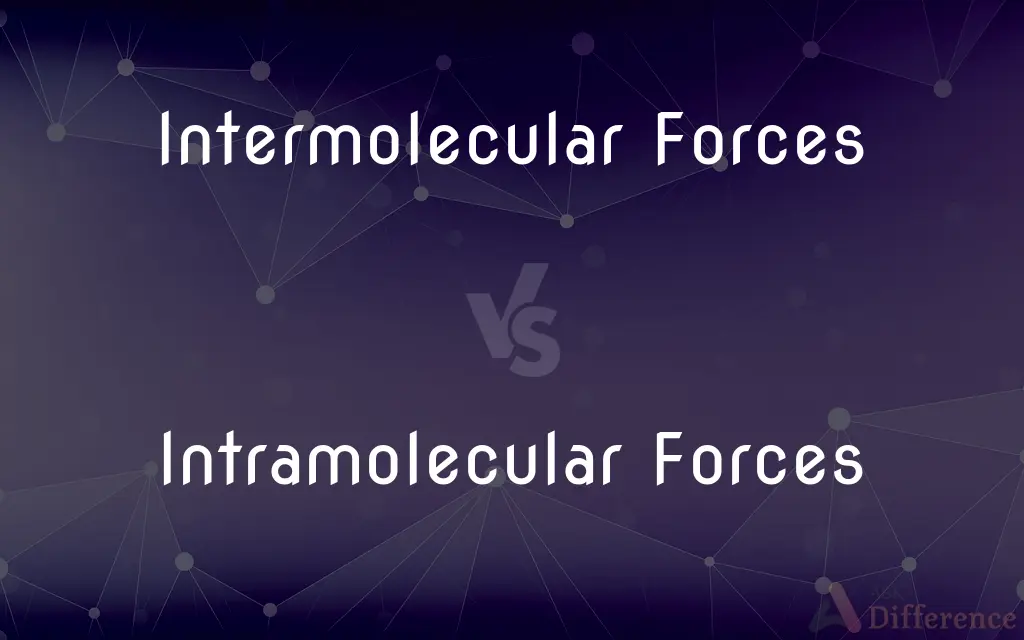Intermolecular Forces vs. Intramolecular Forces — What's the Difference?
Edited by Tayyaba Rehman — By Fiza Rafique — Published on December 25, 2023
Intermolecular Forces act between separate molecules, while Intramolecular Forces hold atoms together within a single molecule.

Difference Between Intermolecular Forces and Intramolecular Forces
Table of Contents
ADVERTISEMENT
Key Differences
Intermolecular Forces are the forces that occur between separate molecules in a substance, holding them together. Intramolecular Forces, on the other hand, are the forces that keep atoms bound within an individual molecule.
The strength of Intermolecular Forces dictates properties like boiling and melting points. Stronger forces result in higher boiling points. Intramolecular Forces, however, determine the stability and type of a molecule, such as whether it's ionic or covalent.
Intermolecular Forces can be of various types, such as van der Waals forces, hydrogen bonding, and dipole-dipole interactions. Meanwhile, Intramolecular Forces include covalent bonds, ionic bonds, and metallic bonds.
The interaction between water molecules due to Intermolecular Forces gives water its unique properties, like its high surface tension. On the contrary, Intramolecular Forces are responsible for the two hydrogen atoms being bound to oxygen in a water molecule.
To summarize, Intermolecular Forces describe the interactions between separate molecules, influencing macroscopic properties. Intramolecular Forces, however, explain how individual atoms are bound together in a single molecule, determining its very nature.
ADVERTISEMENT
Comparison Chart
Definition
Forces between separate molecules.
Forces within a single molecule.
Examples
Van der Waals, hydrogen bonding, dipole-dipole.
Covalent bonds, ionic bonds, metallic bonds.
Influence On
Boiling/melting points, surface tension.
Chemical nature and stability of molecules.
Strength
Generally weaker than intramolecular forces.
Strong forces binding atoms together.
Affected by
Polarities, molecule size, shape, and quantity of charges.
Electronegativity difference, atomic size, bond length.
Compare with Definitions
Intermolecular Forces
Intermolecular Forces are attractions between separate molecules.
The intermolecular forces between water molecules cause them to stick together.
Intramolecular Forces
Intramolecular Forces hold atoms together in a molecule.
The intramolecular forces in water ensure that two hydrogen atoms stay attached to oxygen.
Intermolecular Forces
Intermolecular Forces can arise from charge differences between molecules.
The intermolecular forces in polar solvents make them effective at dissolving ionic solutes.
Intramolecular Forces
Intramolecular Forces are responsible for the specific structure of molecules.
Because of intramolecular forces, methane has a tetrahedral shape.
Intermolecular Forces
Intermolecular Forces dictate how molecules interact with each other.
The strength of intermolecular forces in a liquid determines its boiling point.
Intramolecular Forces
Intramolecular Forces define the chemical nature of a substance.
Different intramolecular forces result in the formation of various isomers of a compound.
Intermolecular Forces
Intermolecular Forces reflect the interactions and attractions among molecules.
Due to the weak intermolecular forces in gases, they expand to fill a container.
Intramolecular Forces
Intramolecular Forces dictate the type of chemical bond in a molecule.
The strong intramolecular forces in diamonds are due to covalent bonding.
Intermolecular Forces
Intermolecular Forces are responsible for cohesion and adhesion in substances.
Because of intermolecular forces, mercury forms beads on a surface.
Intramolecular Forces
Intramolecular Forces arise from attractions between atoms within a molecule.
In salt, the intramolecular forces are ionic bonds formed due to attractions between sodium and chlorine atoms.
Common Curiosities
Which forces affect boiling points, Intermolecular or Intramolecular Forces?
Intermolecular Forces.
What determines the type of bond in a molecule, Intermolecular or Intramolecular Forces?
Intramolecular Forces.
And an example of Intramolecular Forces?
The covalent bond between hydrogen and oxygen in a water molecule.
Can Intermolecular Forces exist in gases?
Yes, but they are generally much weaker compared to liquids or solids.
What are Intermolecular Forces?
They are forces acting between separate molecules.
How do Intramolecular Forces differ?
They are forces that hold atoms together within a single molecule.
What's an example of Intermolecular Forces in action?
Hydrogen bonding between water molecules.
Which force is responsible for the shape of a molecule?
Intramolecular Forces.
Are Intermolecular Forces typically weaker or stronger than Intramolecular Forces?
They are typically weaker.
Are Intramolecular Forces responsible for chemical properties?
Yes, they determine a molecule's stability and reactivity.
What role do Intramolecular Forces play in chemical reactions?
They determine bond breakage and formation during reactions.
What type of Intramolecular Force is in a salt crystal?
Ionic bond.
Do all liquids have Intermolecular Forces?
Yes, but their strengths can vary significantly.
How do Intermolecular Forces influence solubility?
Similar Intermolecular Forces can make substances soluble in each other.
Why do some substances have high melting points, Intermolecular or Intramolecular Forces?
It's due to strong Intermolecular Forces.
Share Your Discovery

Previous Comparison
Maid of Honor vs. Matron of Honor
Next Comparison
Porterhouse vs. TomahawkAuthor Spotlight
Written by
Fiza RafiqueFiza Rafique is a skilled content writer at AskDifference.com, where she meticulously refines and enhances written pieces. Drawing from her vast editorial expertise, Fiza ensures clarity, accuracy, and precision in every article. Passionate about language, she continually seeks to elevate the quality of content for readers worldwide.
Edited by
Tayyaba RehmanTayyaba Rehman is a distinguished writer, currently serving as a primary contributor to askdifference.com. As a researcher in semantics and etymology, Tayyaba's passion for the complexity of languages and their distinctions has found a perfect home on the platform. Tayyaba delves into the intricacies of language, distinguishing between commonly confused words and phrases, thereby providing clarity for readers worldwide.














































